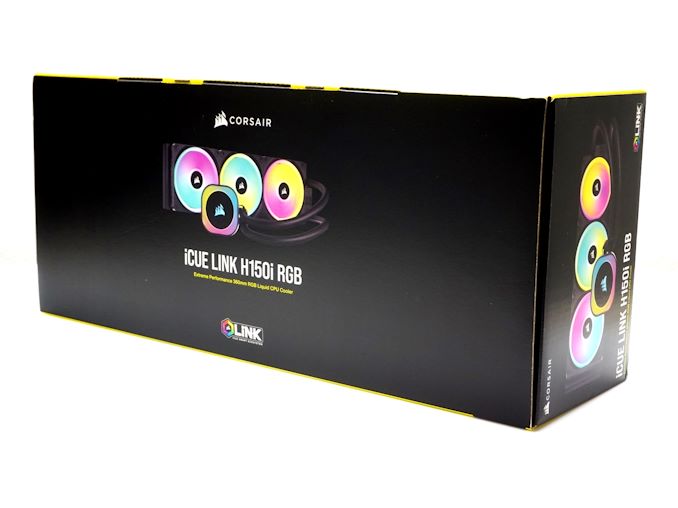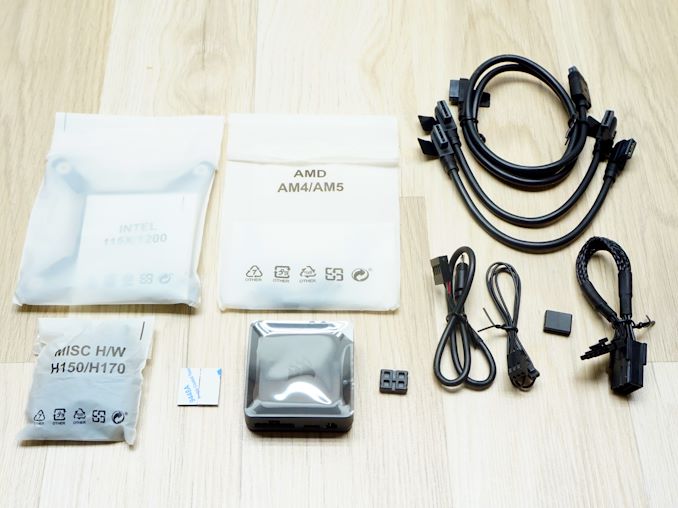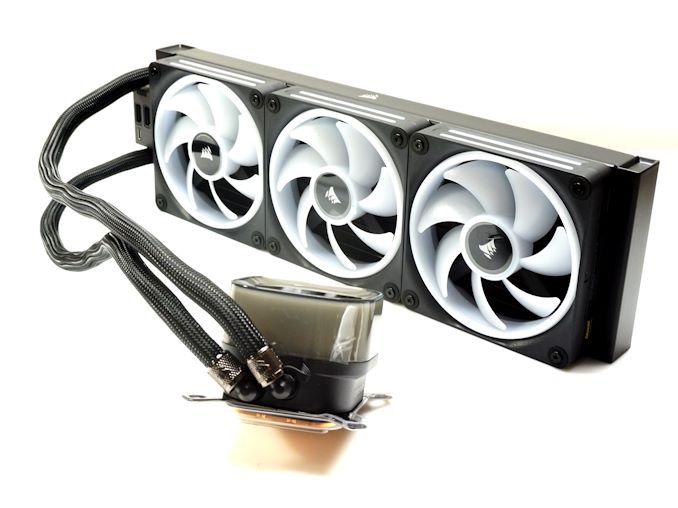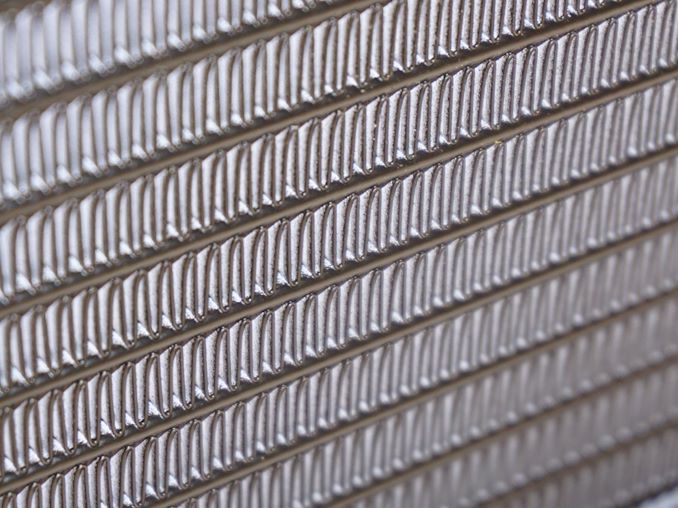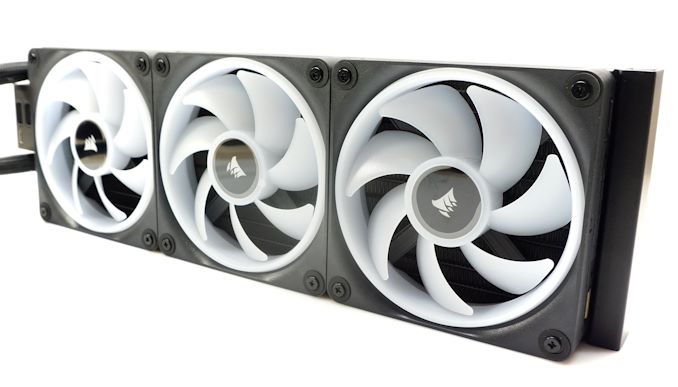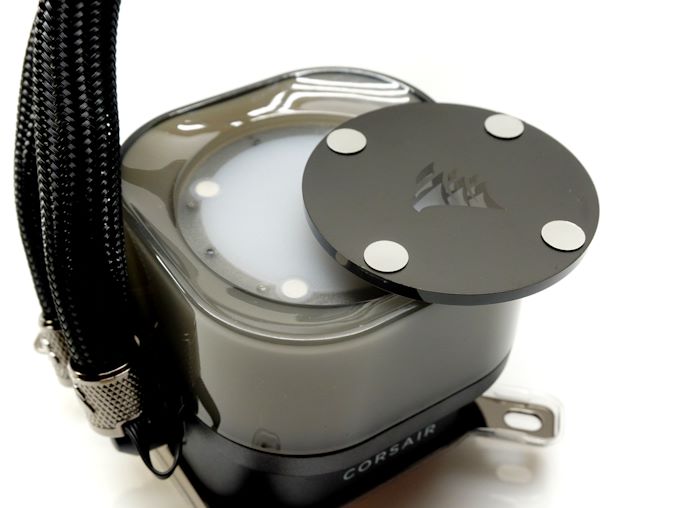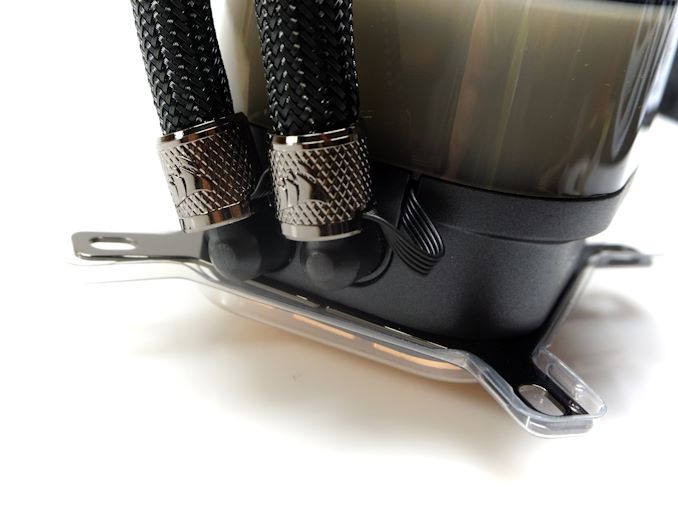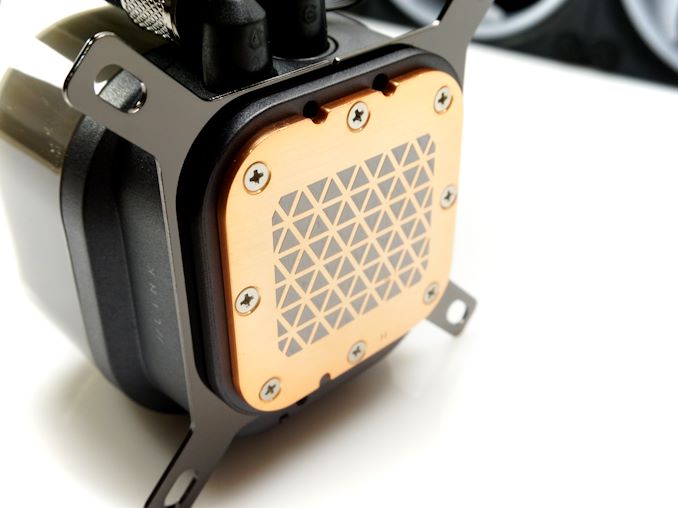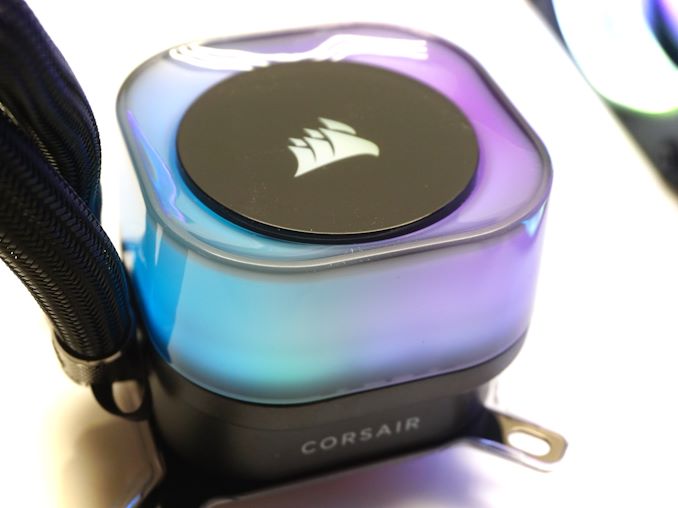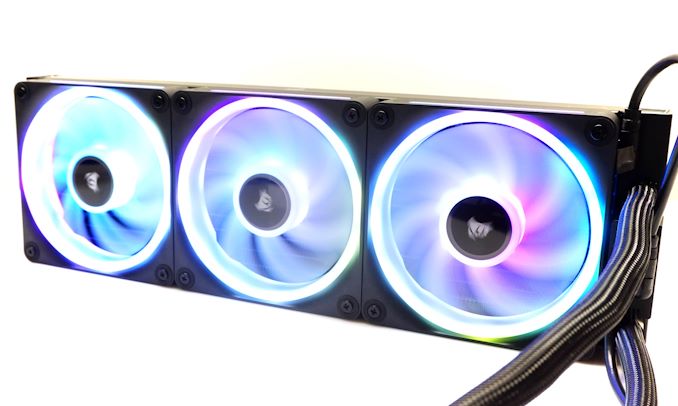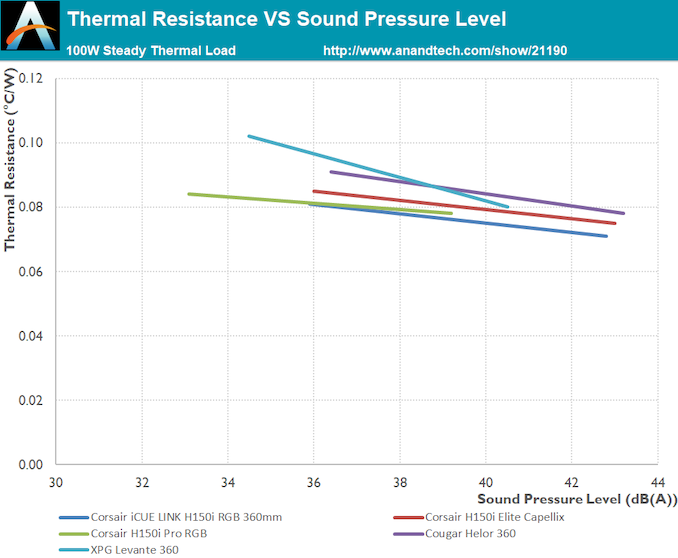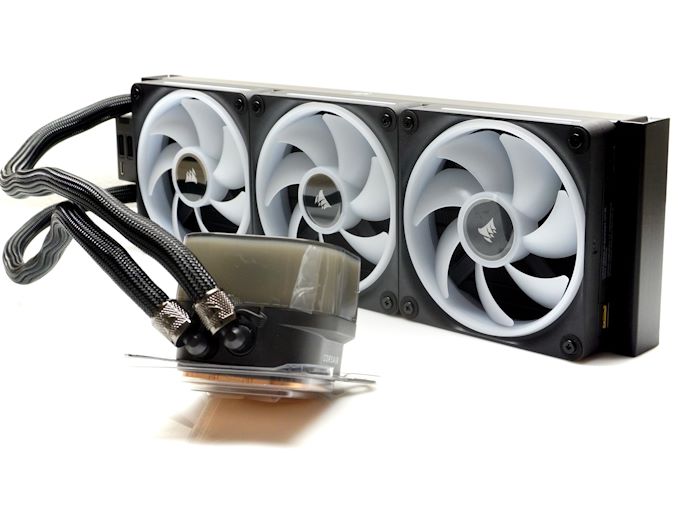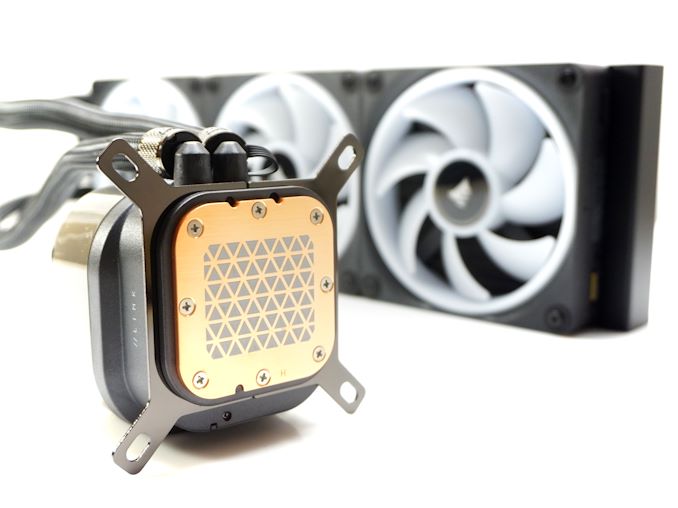
Original Link: https://www.anandtech.com/show/21190/the-corsair-icue-link-h150i-rgb-360mm-aio-cooler-review
The Corsair iCUE LINK H150i RGB 360mm AIO Cooler Review: Colorful Connections
by E. Fylladitakis on January 2, 2024 9:00 AM EST- Posted in
- Corsair
- Cases/Cooling/PSUs
- AIO
- Water Cooling
- Liquid Cooling
- iCUE
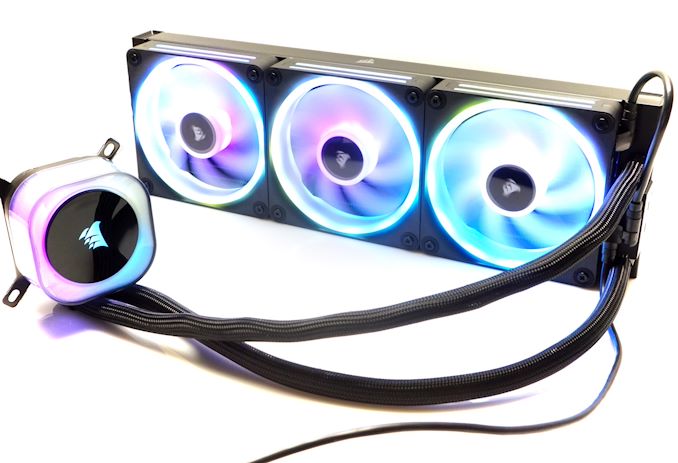
When it comes to all-in-one liquid coolers for CPUs, there are a handful of companies whose brands have become synonymous with the titanic coolers. And of those brands, it's Corsair who is inevitably at the top of any list. One of the key manufacturers responsible for popularizing AIO coolers with the enthusiast PC community, the company has built a very successful and well-renowned business segment out of providing maintenance-free AIO cooler designs – a history that at this point spans over 20 years.
With such a long history, we've seen Corsair update their cooler designs several times now, continually iterating on their designs to improve performance, increase reliability, or even just add RGB lighting to match modern styles. Most recently, Corsair introduced their iCUE LINK family of coolers, which incorporate the titular iCUE LINK system that allows for multiple Corsair peripherals to be connected together and controlled via a central hub. Besides simplifying the process of using multiple Corsair devices together, the iCUE LINK system is also designed to cut down on cable clutter by reducing the overall number of cables down to just one: the iCUE LINK cable going to the next-nearest Corsair device.
To that end, today we're taking a look at the latest generation of Corsair's popular H150i cooler, the iCUE LINK H150i RGB. Succeeding the well-received Elite Capellix models, the newest iCUE LINK H150i RGB stands out with its integration into the iCUE ecosystem, while building and improving upon the already solid foundation of the basic H150i cooler design. While the H150i is not technically Corsair's flagship cooler – that honor goes to the massive 420mm H170i series – most cases cannot accommodate coolers larger than the 360mm H150i, making it the most visible of Corsair's increasingly colorful coolers.
| Corsair iCUE LINK H150i RGB 360mm AIO CPU Cooler Specifications | |||
| Type | All-in-One Liquid Cooler | ||
| Dimensions | 397 x 120 x 52 (radiator with fan) 56 x 56 (coldplate) |
||
| Fans | 3 x 120 mm QX120 Magnetic Bearing Fans 2400 RPM (max) |
||
| RGB | Yes (ARGB) | ||
| Supported Sockets | Intel: LGA1700 / LGA1200 / LGA115x AMD: AM5 / AM4 |
||
| Warranty | 5 Years | ||
| Price | $205 | ||
Packaging & Bundle
We received the new iCUE LINK H150i RGB in a sizable cardboard package, indicative of the cooler's dimensions. Consistent with Corsair's branding, the packaging features their signature black and yellow theme. The box is adorned with a vivid image of the iCUE LINK H150i RGB, giving a hint of the product’s aesthetic appeal. Upon opening, we discovered the cooler and its components securely nestled within custom-designed cardboard inserts, ensuring their protection during transit.
As anticipated, Corsair provides all the essential mounting hardware in the box for the iCUE LINK H150i RGB. The hardware for AMD and Intel processors is supplied in separate pouches. In addition to these components, the bundle also features the iCUE Link Hub, a pivotal element in the iCUE ecosystem. The cooler requires the hub to function and cannot be used without it.
A closer look at the provided cables reveals that the iCUE Link hub requires a 6-pin PCI Express connector for power. Corsair probably wanted to save users from the trouble of using a Molex cable just for powering the hub and, truth be told, it is very likely that most users who will be purchasing a iCUE LINK H150i RGB will also be using a powerful PSU with PCI Express connectors to spare – especially now with 12VHPWR/12V-6x6 connectors powering the latest NVIDIA graphics cards. However, there may be cases where the user owns a PSU with just enough PCI Express connectors for the graphics cards, leaving them no choice other than upgrading the PSU or resorting to Molex-to-PCIe adapters. As the iCUE Link hub does not have high power needs, an included adapter or alternative would have been nice.
The Corsair iCUE LINK H150i RGB AIO Liquid Cooler
Upon initial inspection, the Corsair iCUE LINK H150i RGB AIO cooler resembles many other 360 mm AIO coolers available in the market. However, a closer look reveals a distinct feature: the absence of loose cables, which enhances the overall neatness of the design. This cooler follows the standard AIO layout comprising a single radiator, two hoses, and a block that merges a copper CPU contact plate with a mini liquid pump. In contrast to common corrugated tubing, Corsair has chosen to use black sleeved low-permeation rubber tubing for the iCUE LINK H150i RGB. This choice not only provides improved flexibility but also offers a more refined aesthetic appeal.
The iCUE LINK H150i RGB AIO cooler's substantial radiator, at 397 mm in length, necessitates a case that can accommodate three 120 mm fans in a row, as well as provide sufficient space for the radiator's additional bulk. With a thickness of 27 mm, the radiator requires a total clearance of 55 mm when combined with fans for proper installation in a system. In terms of design, the radiator adheres to the standard dual pass cross-flow configuration, featuring tiny fins soldered onto thin oblong tubes, a common design trait shared by the majority of AIO cooler radiators. The relatively low airflow resistance of this radiator, attributable to its thickness, indicates that it is optimized for performance even under conditions of minimal air pressure.
Corsair has the three fans pre-installed on the radiator and there is not a single wire in sight. The QX120 RGB fans are special designs with connectors on the sides of their frames, allowing them to connect directly to each other. Only one short wire is required to connect the first fan to the distribution hub on the radiator itself. Their special frames have LEDs installed behind diffusers on all sides, as well as the inside rim of the fan. We can also spot a small sensor on one of the engine’s supports. These fans feature magnetic levitation engines, which are rare due to their extremely high cost, but are extremely reliable and generate very little noise.
The second port of the distribution hub is required to connect the AIO cooler to the supplied iCUE Link Hub – that is the only cable required to power and control the entire block/radiator assembly. The iCUE Link Hub requires three cable connections: one is the cable that goes to the radiator’s distribution hub, one is the 6-pin PCI Express power cable, and one is a fan header that is used to receive the motherboard’s PWM signal and respectively control the speed of the cooler’s fans.
The main block assembly of the iCUE LINK H150i RGB AIO cooler is relatively large and may initially seem simple, but its square structure conceals intricate design elements. It features an opaque top half with numerous LEDs beneath it, capable of generating immersive lighting effects. Notably, the top plate of the block is detachable, offering users, particularly those with access to 3D printers or CNC machines, considerable aesthetic customization options. In line with its sleek design, the block is free of any external connectors or wires. Instead, all necessary wiring is discreetly routed to the radiator, running internally alongside the liquid tubes' sleeving, contributing to the cooler's clean and uncluttered appearance.
The iCUE LINK H150i RGB AIO cooler is equipped with a square copper contact plate, attached to the block's base using eight screws. The surface of this plate, while not polished to a mirror finish, is meticulously smooth and perfectly flat, ensuring excellent thermal performance. To further enhance its heat transfer efficiency, the cooler comes with Corsair’s own XTM70 thermal paste pre-applied to the contact plate. According to Corsair, this high-quality thermal paste offers superior thermal conductivity, contributing significantly to the cooler's overall cooling effectiveness.
Once all connections are made and powered on, the iCUE LINK H150i RGB AIO cooler transforms into a vibrant display of colors. The LED control is managed through the iCUE LINK interface, with lighting effects customizable via Corsair's iCUE software. Combined with the advanced capabilities of the iCUE software, the range of programming options becomes vast. Users can opt for simple, aesthetic lighting effects or choose practical, indicative ones, such as temperature-dependent colors, alarms, and more. Furthermore, the iCUE LINK module, in tandem with the iCUE software, facilitates complete integration among all compatible Corsair devices. This synergy allows for innovative inter-device manipulation and commands. For instance, users could configure the function row of a compatible keyboard to act as a lighting bar, reflecting the RPM percentage of the cooler's fans, or alter the cooler's lighting hues based on the active mouse profile.
Testing Methodology
Although the testing of a cooler appears to be a simple task, that could not be much further from the truth. Proper thermal testing cannot be performed with a cooler mounted on a single chip, for multiple reasons. Some of these reasons include the instability of the thermal load and the inability to fully control and or monitor it, as well as the inaccuracy of the chip-integrated sensors. It is also impossible to compare results taken on different chips, let alone entirely different systems, which is a great problem when testing computer coolers, as the hardware changes every several months. Finally, testing a cooler on a typical system prevents the tester from assessing the most vital characteristic of a cooler, its absolute thermal resistance.
The absolute thermal resistance defines the absolute performance of a heatsink by indicating the temperature rise per unit of power, in our case in degrees Celsius per Watt (°C/W). In layman's terms, if the thermal resistance of a heatsink is known, the user can assess the highest possible temperature rise of a chip over ambient by simply multiplying the maximum thermal design power (TDP) rating of the chip with it. Extracting the absolute thermal resistance of a cooler however is no simple task, as the load has to be perfectly even, steady and variable, as the thermal resistance also varies depending on the magnitude of the thermal load. Therefore, even if it would be possible to assess the thermal resistance of a cooler while it is mounted on a working chip, it would not suffice, as a large change of the thermal load can yield much different results.
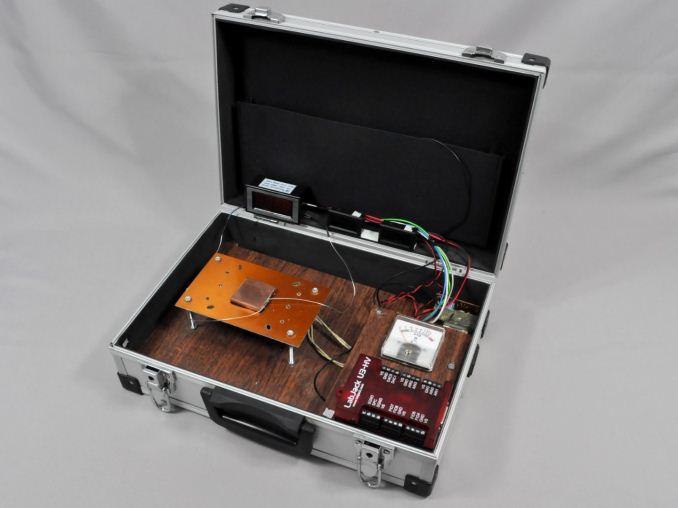
Appropriate thermal testing requires the creation of a proper testing station and the use of laboratory-grade equipment. Therefore, we created a thermal testing platform with a fully controllable thermal energy source that may be used to test any kind of cooler, regardless of its design and or compatibility. The thermal cartridge inside the core of our testing station can have its power adjusted between 60 W and 340 W, in 2 W increments (and it never throttles). Furthermore, monitoring and logging of the testing process via software minimizes the possibility of human errors during testing. A multifunction data acquisition module (DAQ) is responsible for the automatic or the manual control of the testing equipment, the acquisition of the ambient and the in-core temperatures via PT100 sensors, the logging of the test results and the mathematical extraction of performance figures.
Finally, as noise measurements are a bit tricky, their measurement is being performed manually. Fans can have significant variations in speed from their rated values, thus their actual speed during the thermal testing is being recorded via a laser tachometer. The fans (and pumps, when applicable) are being powered via an adjustable, fanless desktop DC power supply and noise measurements are being taken 1 meter away from the cooler, in a straight line ahead from its fan engine. At this point we should also note that the Decibel scale is logarithmic, which means that roughly every 3 dB(A) the sound pressure doubles. Therefore, the difference of sound pressure between 30 dB(A) and 60 dB(A) is not "twice as much" but nearly a thousand times greater. The table below should help you cross-reference our test results with real-life situations.
The noise floor of our recording equipment is 30.2-30.4 dB(A), which represents a medium-sized room without any active noise sources. All of our acoustic testing takes place during night hours, minimizing the possibility of external disruptions.
| <35dB(A) | Virtually inaudible |
| 35-38dB(A) | Very quiet (whisper-slight humming) |
| 38-40dB(A) | Quiet (relatively comfortable - humming) |
| 40-44dB(A) | Normal (humming noise, above comfortable for a large % of users) |
| 44-47dB(A)* | Loud* (strong aerodynamic noise) |
| 47-50dB(A) | Very loud (strong whining noise) |
| 50-54dB(A) | Extremely loud (painfully distracting for the vast majority of users) |
| >54dB(A) | Intolerable for home/office use, special applications only. |
*noise levels above this are not suggested for daily use
Testing Results, Maximum Fan Speed
Our maximum speed testing is performed with both the fans and the pump of the kit powered via a 12V DC source. This input voltage should have the pump and fans matching the speed ratings of the manufacturer. According to Corsair’s specifications, the QX120 fans included with the iCUE LINK H150i RGB should have a rotational speed of 2400 RPM. Our tachometer indicated that the fans were rotating at an average speed of 2390 RPM, very close to their rated specifications.
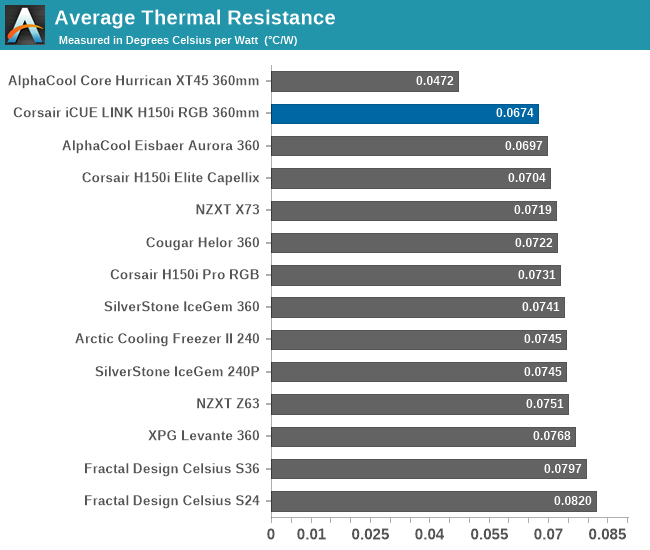
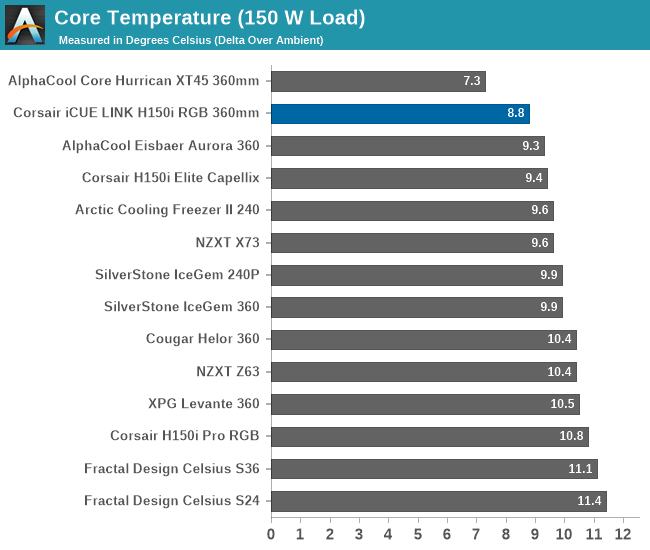
| Core Temperature, Constant Thermal Load (Max Fan Speed) |
The Corsair iCUE LINK H150i RGB AIO Liquid Cooler marginally surpasses its predecessor, the Elite Capellix, in performance. It features an improved Average Thermal Resistance of 0.0674 °C/W and maintains a sound pressure level (SPL) of 42.8 dB(A). This model demonstrates enhanced efficiency, particularly under low-load conditions, which was a limitation in the previous Elite Capellix version. The redesign of the heat transfer plate is most likely responsible for that improvement. Comparatively, the Corsair iCUE LINK H150i RGB showcased exceptional thermal performance among AIO coolers of similar size and consistent performance across a wide range of loads, narrowly outperforming most competitors.
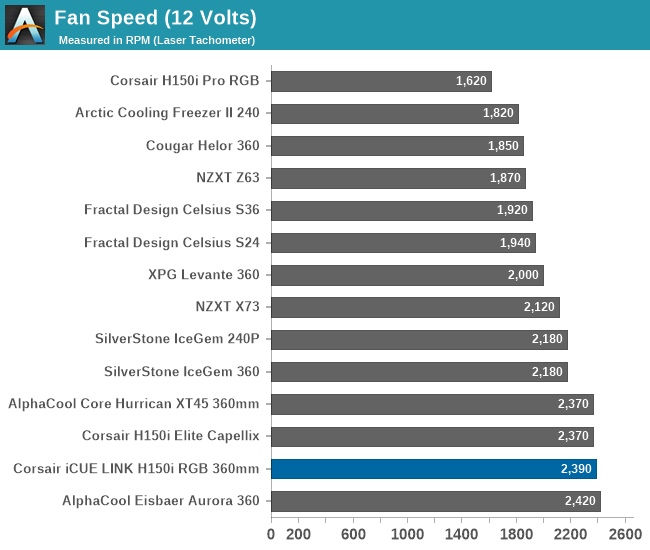
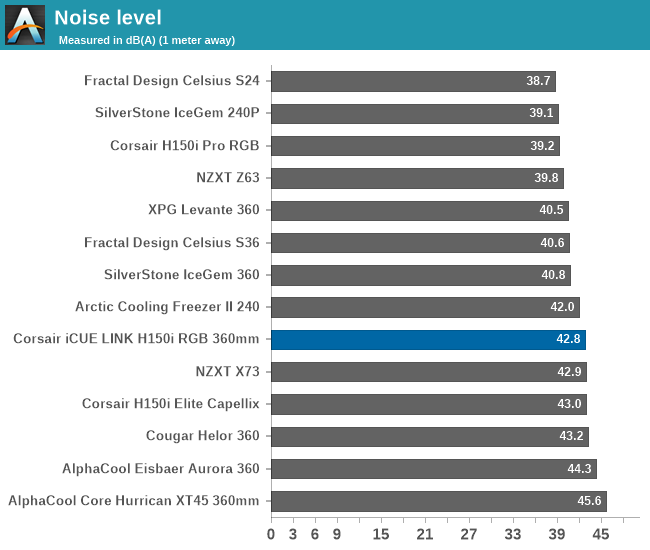
While the Elite Capellix set a high standard in thermal management, often surpassing competitors at full fan speed, it also registered a Sound Pressure Level (SPL) of 43 dB(A) under these conditions. In contrast, the iCUE LINK H150i RGB manages to slightly reduce this noise footprint to 42.8 dB(A), a measurable but slight improvement that, unfortunately, would not be perceptible by any typical user. Still, all improvements are steps in the right direction.
Testing Results, Low Fan Speed
Using a PWM voltage regulator, we reduced the speed of the fans manually down to half their rated speed. At this setting, the 120 mm QX120 fans of the Corsair iCUE LINK H150i RGB rotate at 1200 RPM.

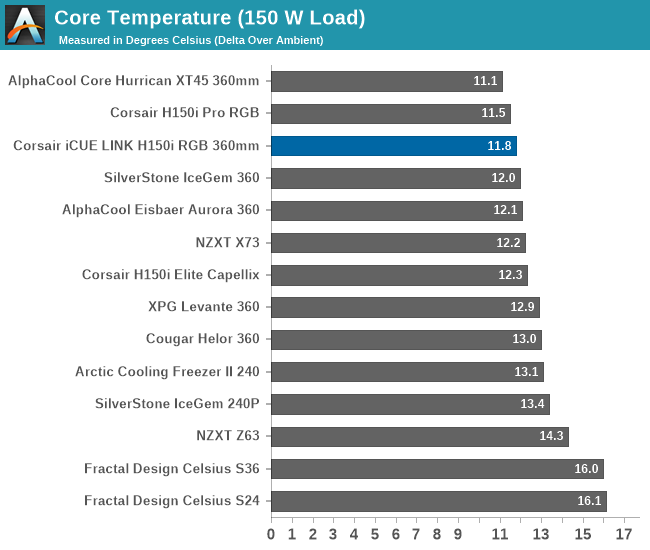
| Core Temperature, Constant Thermal Load (Low Fan Speed) |
The Corsair iCUE LINK H150i RGB AIO Liquid Cooler exhibits a slight edge over the previous generation Elite Capellix, with an Average Thermal Resistance of 0.0771 °C/W. This positions it as a top performer among 360 mm coolers, surpassed only by AlphaCool's open-loop kits. However, it is important to note that this performance comes at the cost of increased acoustics, registering a Sound Pressure Level (SPL) of 35.9 dB(A). This is notably louder than the older H150i Pro RGB, yet it offers improved thermal efficiency.
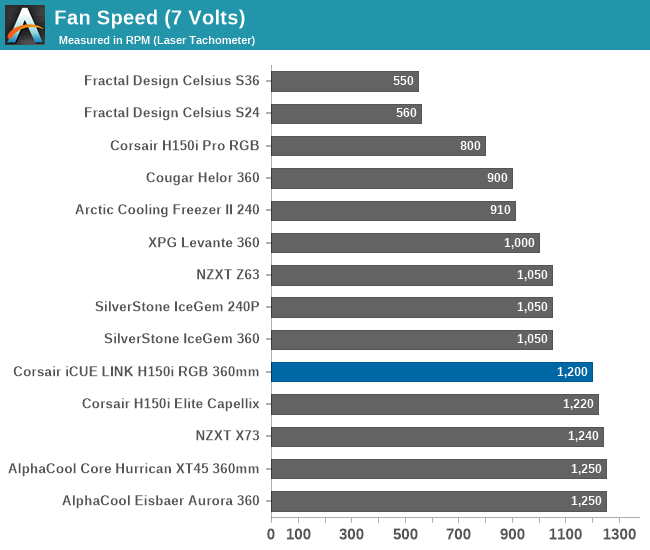
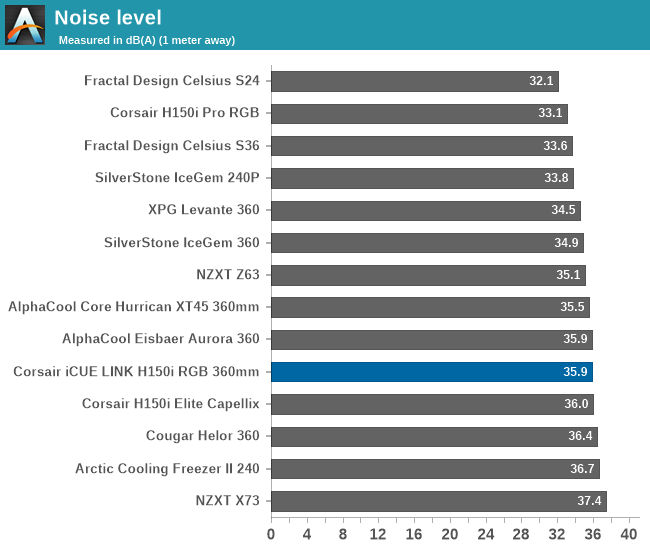
Despite the increase in noise levels compared to the H150i Pro RGB, the iCUE LINK H150i RGB's enhanced thermal performance is noteworthy. This improvement suggests that the cooler might achieve comparable performance to its quieter predecessor if the fan speeds are adjusted to lower levels. The data indicates that while the iCUE LINK H150i RGB's fans operate at a higher speed to achieve this thermal efficiency, resulting in increased noise, it still maintains a competitive edge in cooling performance within its category.
Thermal Resistance VS Sound Pressure Level
During our thermal resistance vs. sound pressure level test, we maintain a steady 100W thermal load and assess the overall performance of the coolers by taking multiple temperature and sound pressure level readings within the operating range of the stock cooling fans. The result is a graph that depicts the absolute thermal resistance of the cooler in comparison to the noise generated. For both the sound pressure level and absolute thermal resistance readings, lower figures are better.
The Corsair iCUE LINK H150i RGB shows an overall enhancement in performance compared to the H150i Elite Capellix, and even slightly surpasses the H150i Pro RGB across its entire operational range. Similarly to the H150i Elite Capellix, the iCUE LINK H150i RGB relies on fast 2400 RPM fans for peak thermal efficiency. However, the iCUE LINK H150i RGB manages to offer better cooling at comparable noise levels, bringing the curve slightly below that of the Elite Capellix.
This improvement suggests that the iCUE LINK H150i RGB could maintain a competitive edge in cooling performance even when operated with its fans at low speeds, similar to those of the venerable H150i Pro RGB. The data further highlights that the advantage of a long and thin 360 mm radiator, as seen in these models, does not significantly benefit from higher airflow due to its extensive heat transfer surface.
Conclusion
The latest generation in the long line of AIO coolers from Corsair, the iCUE LINK H150i RGB AIO Liquid Cooler represents the culmination of over a decade of development in the realm of all-in-one CPU coolers. In a market teeming with AIO solutions, the iCUE LINK H150i RGB stands out, reflecting Corsair's dedication to innovative design and quality. This cooler showcases Corsair's commitment to using premium materials and superior construction techniques, ensuring a product that not only performs well but is also built to last.
The key highlight of the iCUE LINK H150i RGB is its seamless integration into the iCUE ecosystem, a cornerstone of Corsair's product strategy. This integration offers users extensive programmability, both in terms of aesthetics and functionality. The synergy created through the iCUE software extends beyond the cooler, allowing for comprehensive system-wide customization. This includes the ability to synchronize lighting effects across all compatible devices or adjust cooler settings based on specific user profiles. However, this advanced feature set is best utilized with other iCUE LINK-compatible devices, limiting its full potential to within the Corsair ecosystem.
In terms of design, the iCUE LINK H150i RGB follows the standard AIO layout but stands apart with its sleek, cable-free appearance. The use of black sleeved low-permeation rubber tubing adds to its aesthetic and functional appeal. The cooler's radiator, at 397 mm in length, is substantial and optimized for performance with its low airflow resistance design. This design choice ensures efficient cooling even under minimal air pressure conditions.
The main block assembly, with its detachable top plate, offers customization options for users looking to personalize their cooler's appearance. Furthermore, the iCUE LINK H150i RGB is equipped with a square copper contact plate for optimal thermal performance, complemented by Corsair’s high-quality XTM70 thermal paste. The iCUE LINK H150i RGB's cooling efficiency is further enhanced by its magnetic levitation QX120 RGB fans, which are both reliable and operate quietly. The fans' unique design allows for a wire-free look, contributing to the overall sleekness of the setup.
The Corsair iCUE LINK H150i RGB AIO Liquid Cooler represents a small but measurable advancement in cooling technology, showcasing outstanding performance across various operational conditions. It features an improved average thermal resistance of 0.0674 °C/W, indicating its high efficiency in heat dissipation. Performance under low-load scenarios has particularly improved, a notable enhancement from its predecessor. Despite its powerful cooling capabilities, the iCUE LINK H150i RGB can reach a high sound pressure level (SPL) of 42.8 dB(A) with its fans at maximum speed, negating acoustic comfort. Nonetheless, the QX120 fans are extremely versatile and can be operated at any speed, or even stop completely, according to the fan/cooling profile the user selects from inside the iCUE software.
With street pricing for the Corsair iCUE LINK H150i RGB AIO Liquid Cooler running at around $205, the latest H150i cooler represents a premium choice in the realm of high-end cooling solutions, with all of the positives and negatives that entails. Its unique cable-free design not only contributes to a cleaner and more streamlined build but also sets it apart in the crowded market for AIO coolers. The H150i's exceptional application of lighting offers a visually striking and customizable experience, elevating both aesthetics and functionality.
Performance-wise, the iCUE LINK H150i RGB delivers very good cooling efficiency and a very broad operational range, offering exceptional flexibility. And though the price tag is certainly stiff, for users who are willing to invest in a high-budget setup and plan to incorporate multiple iCUE compatible devices, the the H150i is going to be particularly appealing, thanks to its high performance and seamless synergy with the rest of the aestheticly-minded iCUE system.

